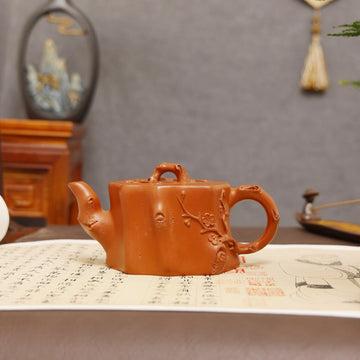Plum Stump Teapot Fully Handcrafted With Red Clay
-
Estimated Delivery:Sep 12 - Sep 16
-
Free Shipping & Returns: On all orders

Plum Stump Teapot Fully Handcrafted With Red Clay
Plum Blossom Stump Teapot | Handcrafted in Original Di Cao Qing Clay
Design & Inspiration
Crafted from premium original Di Cao Qing mineral clay, this teapot embodies the theme of "heralding spring" through vibrant blooming plum blossoms. Its form and artistic intention radiate vitality, capturing the vibrant energy of spring's arrival.
Artistic Details
The body, spout, handle, and lid are intricately designed to mimic organic elements such as plum stumps, bark, and intertwining branches, achieving a natural yet powerful aesthetic. The plum blossoms are adorned using raised-clay techniques, while the spout and handle extend like naturally grown branches, showcasing remarkable biomimetic realism.
Elegant Embellishments
Delicate plum blossoms emerge near the handle and knob, evoking poetic imagery of "fragrant shadows swaying gracefully." The rounded body, sturdy base, and domed lid are executed with precision, reflecting exceptional craftsmanship.
Collector's Piece
Practical yet aesthetically distinguished, this teapot is a masterwork ideal for both collection and daily appreciation, offering outstanding visual and functional appeal.
Teapot Seasoning and Maintenance

1. Seasoning Method
1. Cleaning
Remove any dust or impurities from inside and outside the teapot and its components. Rinse the teapot thoroughly with hot water to warm it up.
2. Initial Brewing
Brew your preferred tea in the pot and pour the tea liquor over the exterior. When the temperature is high, the subtle pores of the teapot expand slightly, allowing moisture to appear on the surface. Gently wipe the body with a tea maintenance cloth while it is still warm. Repeat this entire process at least three times. Note: The tea brewed during this step is not suitable for drinking.
3. Drying
After several rounds of brewing, the “fire energy” (raw kiln feel) of the teapot will be largely reduced. Rinse the pot with clean water and let it air dry completely. It is then ready for daily use.
Tip:
If a strong chemical odor is detected after boiling or if the color of the pot fades, it may indicate a chemically dyed teapot. This method can help identify authentic Zisha clay.
2. Maintenance Principles
-
Before brewing, moisten the outside of the pot with warm water before adding water inside—a practice known as “rinsing the pot.”
-
After use, wipe the exterior with a soft cloth to keep it dry. Avoid leaving tea liquid inside to prevent residue buildup, which may affect the pot’s appearance.
-
Allow the teapot to “rest” for 3–5 days after a period of use, ensuring it dries thoroughly.
-
Keep the pot away from oily or dusty environments to maintain the porous structure of the clay.
-
Follow the “one teapot for one type of tea” rule to prevent cross-flavoring.
-
Never use detergents or chemical cleaners, as they can damage the natural luster of the teapot.
Shipping cost is based on weight. Just add products to your cart and use the Shipping Calculator to see the shipping price.
We want you to be 100% satisfied with your purchase. Items can be returned or exchanged within 30 days of delivery.



Why Choose Pottery Poetry?
Image with text
Pair large text with an image to give focus to your chosen product, collection, or blog post. Add details on availability, style, or even provide a review.
Image with text
Pair large text with an image to give focus to your chosen product, collection, or blog post. Add details on availability, style, or even provide a review.














